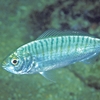General Description
Body slender, compressed; dorsal fin not subdivided into two, anterior dorsal-fin spines low, hind margin of dorsal fin connected to base of tail fin; orbital tentacle simple, very short to absent. Head and body brown, with two or three dark bars extending from behind each eye to gill cover; a black oval spot sometimes below first dorsal fin; dorsal, anal, and tail dark with white tips; pectoral fins with basal quarter dark, remainder with spots forming transverse bands. To 14 cm.
Biology
A rare species in Victorian waters.
Habitat
Amongst vegetation in bays, along the coast and in tide pools, in depths of 0-20 m.
Reefs
Coastal shores
Distribution guide
New Zealand and south-eastern Australia, including western and central Victoria.
Species Group
Fishes › Weedfishes and snakeblennies
Depth
Shore (0-1 m)
Shallow (1-30 m)
Water Column
Max Size
14 cm
Commercial Species
No
Global Dispersal
Recorded in Australia
Conservation Status
- DSE Advisory List : Not listed
- EPBC Act 1999 : Not listed
- IUCN Red List : Not listed





